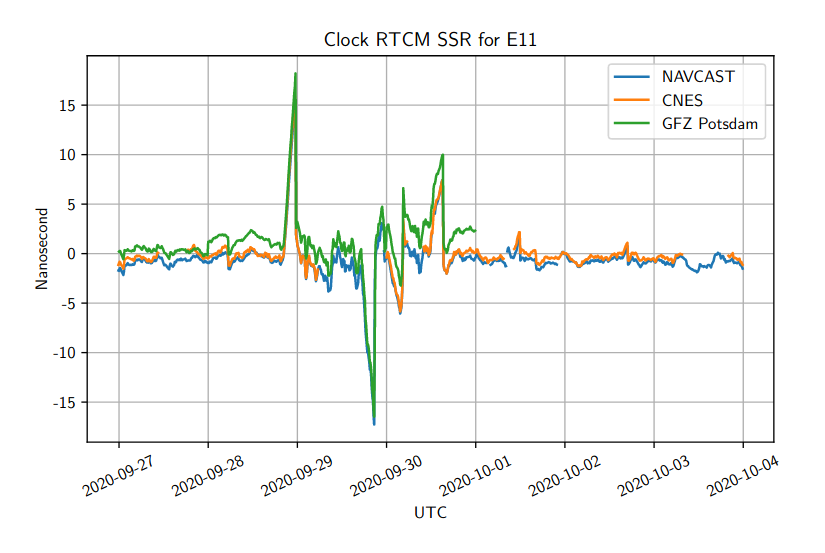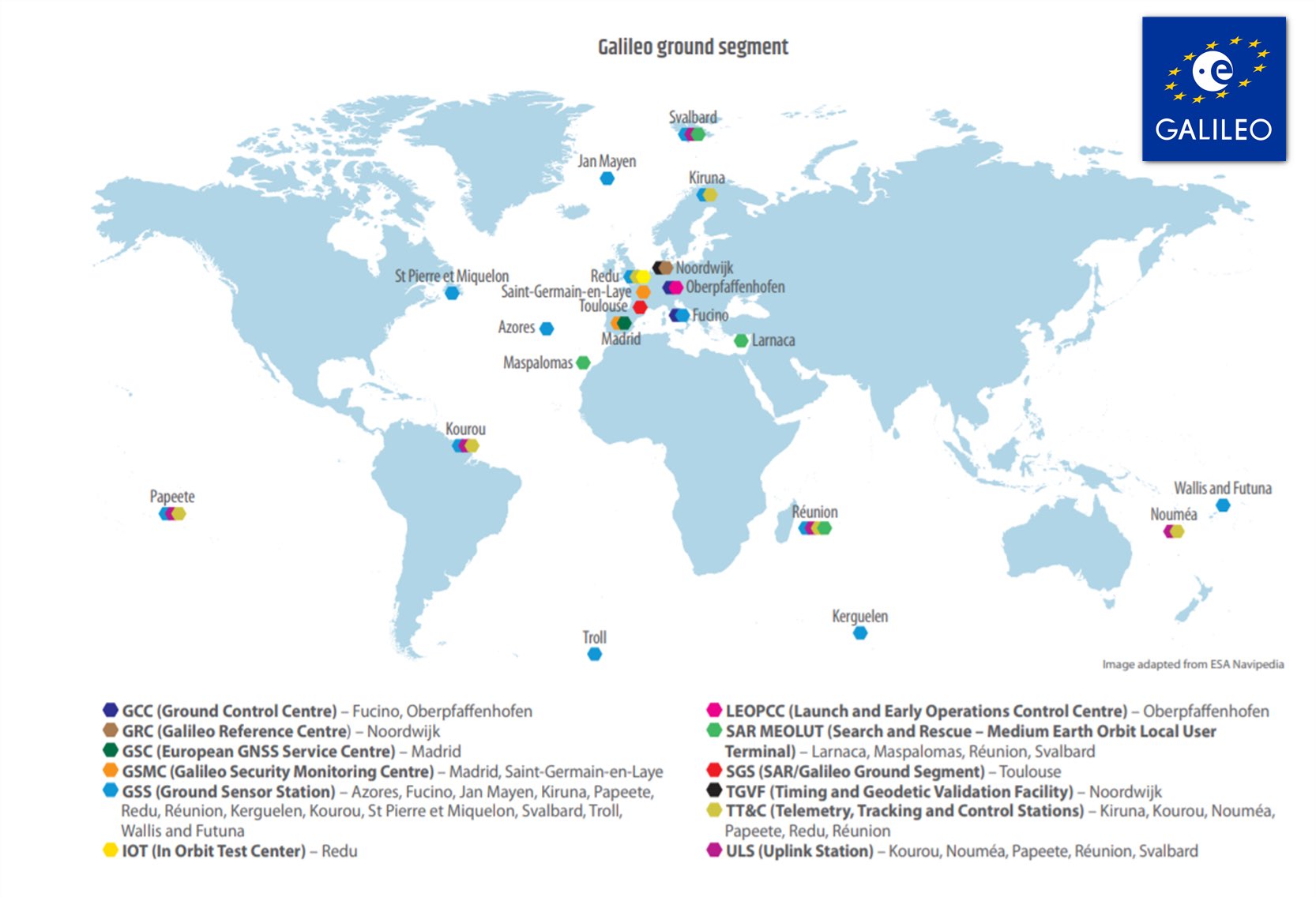Galileo's Ground Segment Problem
Before I explain what is going on, I should hasten to say that most days of the week, Galileo is working well for most users. But for example, Monday the 28th of September, one satellite was off by a stunning 5 meters. For a satellite system claiming 1 meter accuracy, that is rather dire.
UPDATE! On the 27th of October, the Galileo Ground Segment gained two new working satellite dishes, which goes a long way towards solving the problems discussed on this page. This expansion was in the works since 2018, but it is good to see it happen now.

15 nanosecond (5 meter) excursion of E11
A Global Navigation Satellite System (GNSS) helps us determine our position, velocity and time. All three can be very important. For example, the time signal is used to synchronise power production, radio networks and global databases.
For our phone to know where it is, it needs to know two things: where the GNSS satellites are, and the exact status of the clocks on board. By clocking the signals received from space, a GNSS receiver knows exactly how far it is away from the satellites. And from there, it can calculate position, velocity and time on the ground.
Crucially, the orbits in space and the atomic clocks are not entirely regular. To determine our location with the desired precision, we need an update on the “ephemeris” (orbit) and clock around once an hour.
And for the past months, Galileo has struggled to determine and disseminate such orbit corrections in a timely fashion. Typically this problem happens one or two days a week, and so far the satellites have been regular enough this has not degraded precision a lot. Except on the 25th of September.

How the orbit updates are determined & distributed
Monitoring stations all over the world work together to measure the precise orbit of the Galileo satellites, and to determine how far ahead or behind the on-board clocks are.
This information is combined into a fresh “ephemeris” every 10 minutes. This happens for each individual satellite (there are 22 + 2 testing). The ephemeris is then uplinked to the right satellite, which then broadcasts it to users around the world. Because receivers get frequent updates on the orbits and clocks, they can do their work accurately.
Every satellite in space is equipped with four clocks, multiple power supplies, multiple computers, multiple everything, just to make sure there is enough spare capacity to keep things working 24 hours a day for 10 years.
It would then stand to reason to have more than 24 dishes available to talk to the 24 Galileo satellites. From an engineering perspective, it would even make sense to have a large overcapacity in the ground segment. Compared to the cost of building and launching a satellite, this would seem like a reasonable investment to make.
Other uplinking needs
Galileo is evolving and will soon (?) be delivering two new services: the High Accuracy Service which promises realtime updates enabling decimeter level accuracy, and Open Service Network Message Authentication, which adds cryptographic signatures to the navigation messages.
Both of these services require realtime communications from the ground.
In addition, early 2021 will see the launch of two new Galileo Satellites, and these will of course also demand attention from the ground segment.
Uplink capacity
Talking to a Galileo satellite requires a moderately sized dish. A Galileo satellite zips along at 3 kilometers per second, so the dish needs to track the satellite as it moves across the sky.
Because the Earth is round, there can’t just be a single big ground station in Europe somewhere - the uplink facilities need to be spread around the world.
Although over 10 billion euros have been invested in Galileo, for some reason, the uplink capacity has always been limited. Most of the time, only a subset of satellites is in active ground communications. For the past few years, the goal has been that every satellite is in touch with the ground once every 100 minutes at least.

3 of the nominally functional uplink dishes, Réunion Island
This means that the existing satellite dish capacity moves from one satellite to the other to make sure every Galileo satellite gets attention at least once an hour or so.
So this is a very parsimonious design already. From what I read, the goal is that at best, 20 out of 24 satellites can be contacted simultaneously, if everything is working.
It is not working well right now
The nominal capacity is already not ‘100%’, but frequently things are not nominal. In a typical week, at least one or two days see Galileo satellites not being provisioned with new information on time.
A cursory look at update frequencies teaches us that often only 13 dishes are talking to the Galileo satellites.

Svalbard, home of a Galileo uplink station. Source
The causes may be diverse - for various reasons, many uplink stations are hosted on remote islands or Nordic archipelagos. Given COVID-19, it is not always easy to reach these islands to do maintenance or expansion work.
In addition, some monitoring stations were hosted on UK territory, and it seems this may no longer be working out post-Brexit.
Due to further technical reasons, dishes that are not available have a knock-on effect on reincorporating satellites into the network. The results of uplink station problems can therefore last long after the initial problem was fixed.
Aging satellites need more frequent contact with the ground
Galileo should be flying 24 operational satellites - but it is not, there are 22 that work. This number was only reached by keeping engineering prototypes in production, which is great when it works. Galileo tries real hard to keep 22 satellites operational.
Over time, atomic clocks degrade and can become unruly. The oldest currently functioning Galileo satellite (E11) has such an unruly clock. This is not a problem if corrections are received every 10 minutes, as is the nominal schedule.
Late September 2020, communications broke down and E11 continued to function without feedback, leading its clock to accumulate a 5+ meter equivalent error, twice - but not broadcasting a warning about that.
Galileo satellites are very dependable but also not very autonomous - once out of reach from the ground, for a very long time a satellite will do exactly what it was told. In this case however, E11 should copy a trick from some other Galileo satellites, and learn how to declare itself unreliable (‘working without guarantee’) if it hasn’t heard from the ground recently.
Because as it stands, most Galileo satellites will happily continue broadcasting a healthy status for 24 hours even if they haven’t been in ground contact. For some satellites this is a reasonable configuration - but for others, it is very much not.
How did this happen?
I am not quite sure. Galileo is famously a 10 billion euro project. You’d think there would be enough money to buy and operate 40 moderately sized satellite dishes.

The Galileo ground segment. Source, EU DEFIS Tweet
Ground stations are expensive, although it is not always immediately clear why. A “Galileo-grade” uplink dish plus steering & other hardware should cost around 150k euros, I am told. I’m sure the Galileo-specific bits will double that, but it is still a doable amount of money compared to the cost of a single satellite (65 million euros, excluding launch).
Much like you can hire a consultant and pay 2500 euros a day, but that consultant actually makes nowhere near that kind of money, it seems plausible that individual Galileo uplink dishes are billed at “millions/year” rate, once you order them over at Thales Alenia Space.
It is also entirely possible that the ‘uplink facility’ was tendered in such a way that additional capacity was priced to compensate for lower initial tender prices. This is very common when doing large scale procurement - trading a short term saving for a longer term steeper price.
People with time on their hands might be able to figure this out by trawling through the European Union’s tendering site.
Now what?
It seems that this problem has been around for a very long time, so it likely can’t be solved easily. From what I understand, work is in progress to deliver at least the nominal 20 dishes, and this is very good.
Meanwhile, it might be a stellar idea to copy the ‘Working Without Guarantee’ functionality from the two ’testing’ vehicles to all other Galileo satellites. This would at least enable Galileo to be a “good GNSS citizen” by configuring satellites to mark themselves faulty if they aren’t sure they are doing a good job. There’s always GPS to fall back on!
And for the longer term.. people might start asking questions why the ground segment is so anemic compared to the glorious satellites that fly in space, and why this makes sense.
